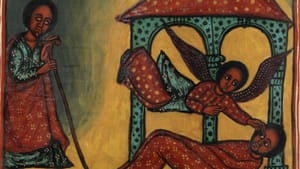Stay in the Loop
BSR publishes on a weekly schedule, with an email newsletter every Wednesday and Thursday morning. There’s no paywall, and subscribing is always free.
How Black Americans portrayed themselves
The Library Company of Philadelphia presents ‘From Negro Pasts to Afro-Futures'

In his introduction, the Library Company’s Michael J. Barsanti pointed out that the institution’s focus on African American history is well established, starting with its April 1969 exhibit, Negro History, 1553–1906, held jointly with the Historical Society of Pennsylvania. The success of the 1969 exhibit led to a catalogue of these holding at the Library Company and has been followed by continued growth of the collection and the establishment of a first-rate Program in African American History (PAAH), in 2007.
Choosing their mediums
At the May 24 exhibition opening, current PAAH director Dr. Deirdre Cooper Owens said it’s important to “turn around the white lens” and see how Black people in America portrayed themselves in art and writing: “We want to show how Black people turned the tide against crude stereotypes of themselves when they curated themselves in the mediums of their choice.”
To kick off the exhibit, mezzo-soprano Marquita Raley selected a gamut of historically significant music. One of the songs, “How Shall I Woo Thee?,” comes from the Paul Laurence Dunbar poems set to music by Samuel Coleridge-Taylor. Coleridge-Taylor, who was born in London in 1875 to a mother from England and a father from Sierra Leone, became a successful composer in a society that forbade his father from working as a doctor. He discovered African American spirituals when he heard the Fisk Jubilee Singers from Fisk University in Nashville, Tennessee, as they toured England in the late 1800s.
The items chosen for the exhibit do not cohere to any particular theme or time period but jump from sacred African Christian texts to chromolithographs of African traders of enslaved people. Although each piece is fascinating on its own, a more unified message could have strengthened the show’s impact.
Rare opportunities
Dersane Mikael, the Ethiopian manuscript from Gondar, c. 1682 (given to the Library Company by Countess Van Cuelenbroeck in 1900), is breathtaking. The illustrations are in vivid colors, one of which has been reproduced on the wall by the display. The beautiful calligraphy of the ancient liturgical language is spellbinding, as are the illustrations of the graceful, amber-skinned Biblical figures. There are very few Ethiopic manuscripts in existence, so if you wish to see the 17th-century Homilies of Michael, this is a rare opportunity to visit it in a quiet setting.

Other rarities on display are the artistically designed scrapbooks known as friendship albums. Friends and relatives contributed pages of art, portraits, and poetry to the owner’s album. There are contributions from many famous African Americans of the day, including Sarah Mapps Douglass, a gifted artist whose beautiful watercolors were created for the album of Amy Matilda Cassey, a member of the Philadelphia Female Anti-Slavery Society and founder of the Gilbert Lyceum. The album pages have been loaded onto an iPad, making it easy to examine the intricate details of the drawings and calligraphy.
Disturbing images
The Michael and Nicholas Hanhart chromolithograph of Gezo, King of Dahomey (now southern Benin), is a glaring example of a piece that does not fit the theme of battling historical stereotypes. King Gezo made a fortune from slavery, and the frontispiece is from a book by Victorian army officer Frederick E. Forbes, recounting his missions to visit the great king in his court.
Another item on display is a Philadelphia artist’s 1950 photograph of two babies lying on a bed of cotton bolls. This disturbing image certainly does more to reflect on lifelong enslavement than to envision another future.
They won't be suppressed
Owens and African American history specialist Jasmine Smith worked with students of color from Queens College, under the Library Company’s team of curatorial experts, to create the show. Thanks to graduate students Jermaine Dennis, Kimani Magloire, Tamara Potts-Covan, Julian González, and Carolina Acosta, the exhibit brings to the fore some of the lesser-known holdings of the Library Company of Philadelphia and demonstrates the value of its tremendous collection of Africana. The variations in theme perhaps make the exhibition more powerful, as each piece inspires debate and discussion.
As I left the exhibit, I imagined Library Company founder Benjamin Franklin (who himself enslaved people before becoming a prominent abolitionist near the end of his life) informing Philadelphia police commissioner Frank Rizzo, who sent officers to beat up Black students demanding courses in African American Studies in 1967, that these histories, art, and dreams will not be suppressed.
What, When, Where
From Negro Pasts to Afro-Futures: Black Creative Re-Imaginings. Through October 18, 2019, at the Library Company of Philadelphia, 1314 Locust Street, (215) 546-3181 or librarycompany.org.
The entrance and exhibit space of the Library Company of Philadelphia is barrier free. ADA-accessible restrooms are also available. Barrier-free parking is available in two nearby lots, and SEPTA service to Locust Street is also accessible by bus and at the Walnut-Locust station.
Sign up for our newsletter
All of the week's new articles, all in one place. Sign up for the free weekly BSR newsletters, and don't miss a conversation.

 Margaret Darby
Margaret Darby